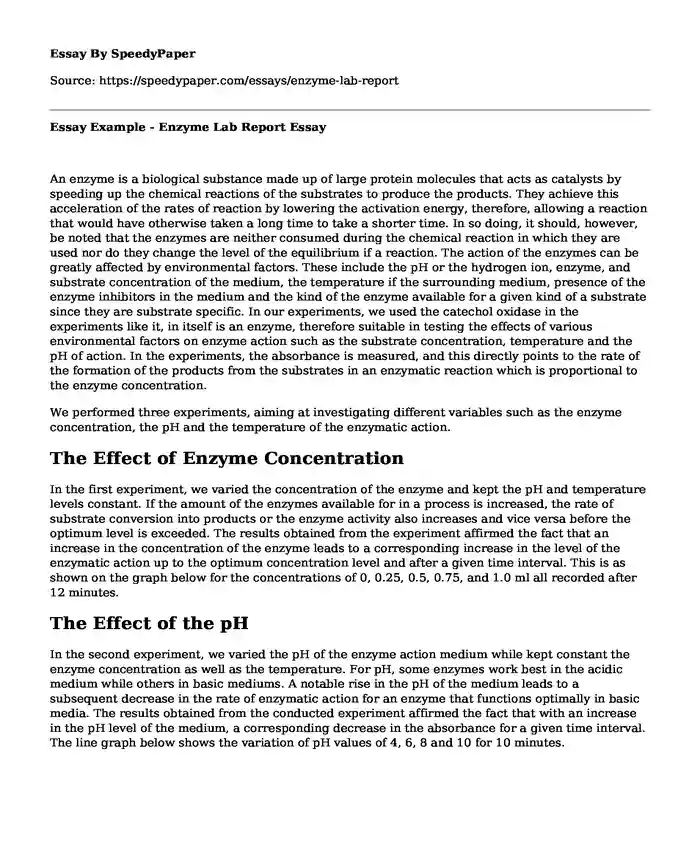
| Type of paper: | Report |
| Categories: | Knowledge Data analysis Biology |
| Pages: | 3 |
| Wordcount: | 819 words |
An enzyme is a biological substance made up of large protein molecules that acts as catalysts by speeding up the chemical reactions of the substrates to produce the products. They achieve this acceleration of the rates of reaction by lowering the activation energy, therefore, allowing a reaction that would have otherwise taken a long time to take a shorter time. In so doing, it should, however, be noted that the enzymes are neither consumed during the chemical reaction in which they are used nor do they change the level of the equilibrium if a reaction. The action of the enzymes can be greatly affected by environmental factors. These include the pH or the hydrogen ion, enzyme, and substrate concentration of the medium, the temperature if the surrounding medium, presence of the enzyme inhibitors in the medium and the kind of the enzyme available for a given kind of a substrate since they are substrate specific. In our experiments, we used the catechol oxidase in the experiments like it, in itself is an enzyme, therefore suitable in testing the effects of various environmental factors on enzyme action such as the substrate concentration, temperature and the pH of action. In the experiments, the absorbance is measured, and this directly points to the rate of the formation of the products from the substrates in an enzymatic reaction which is proportional to the enzyme concentration.
We performed three experiments, aiming at investigating different variables such as the enzyme concentration, the pH and the temperature of the enzymatic action.
The Effect of Enzyme Concentration
In the first experiment, we varied the concentration of the enzyme and kept the pH and temperature levels constant. If the amount of the enzymes available for in a process is increased, the rate of substrate conversion into products or the enzyme activity also increases and vice versa before the optimum level is exceeded. The results obtained from the experiment affirmed the fact that an increase in the concentration of the enzyme leads to a corresponding increase in the level of the enzymatic action up to the optimum concentration level and after a given time interval. This is as shown on the graph below for the concentrations of 0, 0.25, 0.5, 0.75, and 1.0 ml all recorded after 12 minutes.
The Effect of the pH
In the second experiment, we varied the pH of the enzyme action medium while kept constant the enzyme concentration as well as the temperature. For pH, some enzymes work best in the acidic medium while others in basic mediums. A notable rise in the pH of the medium leads to a subsequent decrease in the rate of enzymatic action for an enzyme that functions optimally in basic media. The results obtained from the conducted experiment affirmed the fact that with an increase in the pH level of the medium, a corresponding decrease in the absorbance for a given time interval. The line graph below shows the variation of pH values of 4, 6, 8 and 10 for 10 minutes.
The Effect of Temperature
In the third and the final experiment, the temperature of the enzyme action medium was varied while the pH and the concentration of the enzyme were kept constant. An increase in the temperature of the enzyme action medium up to an optimum temperature value leads to a subsequent increase in the rate of absorption. Any temperature increase beyond the optimum temperature value leads to a decrease in the rate of enzymatic action. The data obtained from the experiment conducted affirms this hypothesis. The graph below denotes the variation of the absorption rate against the temperatures at 5, 25, 50, and 100 degrees Celsius recorded after 6 minutes.
In conclusion, the data collected and the graphs plotted reveal how the three factors affect the rate of enzymatic action. For the concentration of the enzymes, it is seen that the higher the enzyme concentration, the higher the rate of the absorbance up to a certain concentration level called the optimum concentration from where any further increase in the enzyme concentration leads to a decrease in the absorbance. The scenario can be alternatively explained that an increased amount of the enzyme works faster on the available substrate; therefore, increasing the absorbance. A similar trend is witnessed in the temperature variation case. It can be said that the initial increase in the rate of enzymatic action with the temperature is due to the activation and provision of extra kinetic energy to the particles at the active sites. A subsequent drop in the absorbance on exceeding the optimum temperature could be attributed to the fact that such higher temperatures denature the enzymes, therefore, disabling their active sites. Finally, the analysis of the effects of pH reveals that the enzyme under observation here works well in the basic media than the acidic media. This is illustrated by the initial drop in absorbance while in the acidic pH ranges and a rise in the absorbance while stepping to the basic pH ranges of more than 7.
Cite this page
Essay Example - Enzyme Lab Report. (2023, Jan 10). Retrieved from https://speedypaper.net/essays/enzyme-lab-report
Request Removal
If you are the original author of this essay and no longer wish to have it published on the SpeedyPaper website, please click below to request its removal:
- Mindfulness: Influencing Patient and Care Team Experience. Free Essay.
- Hurricane Relief Essay Sample
- Free Essay: Features of Amazon E-Commerce Website
- Quality and People Management at Jaguar Land Rover's Closed-loop Manufacturing
- Free Essay Focusing on Kotter's 8 Steps and Blue Ocean Strategies
- Valeant's Secret Division - Business Ethics Essay Example
- Essay Sample on the Current Public Health Issue of Interest: Lung Cancer Disease Surveillance
Popular categories




